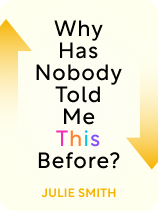

This article is an excerpt from the Shortform book guide to "Why Has Nobody Told Me This Before?" by Julie Smith. Shortform has the world's best summaries and analyses of books you should be reading.
Like this article? Sign up for a free trial here.
Do you experience anxiety or low moods? Are you dealing with the pain of a loss?
Emotions are great when they’re joy, contentment, or excitement. But, difficult emotions are a lot less fun. In Why Has Nobody Told Me This Before?, Dr. Julie Smith discusses how to understand and relate to your emotions and reduce the power they have over you—without reliance on medication or therapy.
Keep reading to learn how to deal with difficult emotions such as low mood, anxiety, and grief.
How to Deal With Difficult Emotions
According to Smith, one of the main reasons people go to therapy is to rid themselves of painful and difficult emotions and moods. But, she writes that, instead of aiming to erase all painful emotional experiences from your life (which isn’t possible), you should try to change your relationship to these experiences and learn ways to lessen their intensity.
The first step to changing your relationship with difficult emotions is understanding what they are and the purposes they serve. Then, you can practice different methods to lessen their negative impact. To begin, let’s examine what Smith says about unpleasant and painful emotions in general and then take a closer look at how to deal with difficult emotions (specifically low mood—which includes depression and sadness—anxiety, and grief).
(Shortform note: The idea that you can improve your mental health by changing your relationship with painful emotions is the foundation of a theory and approach in psychology called Acceptance and Commitment Therapy (ACT). ACT is based on the premise that every emotion, including negative ones, is a natural and normal part of the human experience that should not be feared. Instead of trying to get rid of your emotions, ACT teaches you to develop awareness of them and allow their presence.)
What Are Emotions?
The most important thing to know about emotions is that they are a normal part of the human experience, and it’s healthy to have a range of emotions, even if some of them are negative. According to Smith, life isn’t about being happy and content all the time—it’s about meeting challenges, adapting to change, and, ultimately, surviving to see another day. Emotions are a natural response to your physical and psychological states as you navigate these changes and challenges.
Emotions are your brain’s attempt to make sense of what’s happening, both inside you and in the world around you. When you experience an event, your brain takes all the information it gathers from your senses, your body (your heart rate, blood pressure, breathing rate, hormones, and the like), and your memories of when you felt similarly in the past. It then makes an interpretation of all the data it has, which we often experience as emotions.
How to Relate to Your Emotions
Our feelings can provide valuable information, but they don’t necessarily reflect the whole truth of a situation. This means that we shouldn’t rely solely on emotions to dictate how we behave, make decisions, or interact with others, because, if we don’t take a beat to consider other information or perspectives, we can hurt our relationships and get stuck in harmful ruts of behavior.
However, because emotions can give you a clue about something you may need, it’s helpful to develop a relationship with them to better understand and work with them. To do so, Smith says you should develop both awareness and acceptance of your emotions.
Develop awareness of your emotions. When you can consciously identify your emotions, you create space between you and your feelings so that you can pause, reflect, and assess the bigger picture. This enables you to act based on all available information as well as your values. When you’re emotionally aware, you can also recognize what your emotions are telling you about what you need. Smith says emotions often try to communicate a physical need: You may be tired, over-caffeinated, hungry, too hot or cold, or you may need to move your body.
Practice accepting your emotions. Many people fear feeling emotions because they’re taught that emotions are inappropriate and should be hidden and denied, or because emotions can be overwhelming and frightening. But Smith writes that you shouldn’t resist or attempt to escape your emotions, because trying to stop them actually makes you feel worse. Even when you can numb your emotions with things like alcohol, television, and social media, you’re not actually making them disappear—the emotions will be waiting for you once your distraction ends. In addition, those coping methods can be self-destructive or point us down a path that leads away from our long-term goals and values.
Instead, understand that emotions are not permanent. Smith explains that if you can notice an emotion, accept that it’s happening, and let yourself feel it, then the emotion will pass through you and dissipate.
How to Lessen the Power of Your Emotions
Smith acknowledges that letting yourself feel your emotions is difficult, as emotions can be painful and intense. Because of this, it’s important to gain tools to help you lessen your emotions and make them more manageable. Smith teaches that practicing mindfulness, accurately naming your emotions, and working with your thought patterns can help you make your emotions feel less powerful and reduce their impact on you.
Mindfulness: Mindfulness is the practice of observing your sensations and thoughts without assessing them as good or bad and then letting them pass. You can practice mindfulness through formal meditation, or more informally while you’re walking, showering, or doing other mundane tasks. Mindfulness can help you distance yourself from your thoughts, emotions, and experiences to see them from a broader perspective.
Name your emotions: The words we use to describe emotions shape how we experience and make sense of the world. When we can accurately define negative emotions, we can be more flexible in responding to situations. Additionally, labeling a painful feeling helps us regulate our emotions, relieve stress, and avoid the negative effects of trauma. Emotions can be tricky to label—often, we don’t just feel one emotion at a time but a mixture of contradictory ones. Smith recommends building a nuanced emotional vocabulary for the full range of positive and negative emotions and actively using those words daily.
Notice and shift your thought patterns: Smith explains that our thoughts can often arouse and worsen emotions. Further, they can turn into unhelpful thought patterns in response to difficult circumstances and painful emotional states. Understanding and noticing these patterns can help you break out of them to lessen their negative impact on your emotions and moods.
These are some of the thought patterns that we tend to fall into, which can lead us to misinterpret situations and worsen our emotions and moods:
- Personalizing: We automatically make things about ourselves when we don’t have enough information to draw any conclusions.
- Broad-brushing: When one thing goes badly, we anticipate that nothing else will go right for us again.
- Black-and-white thinking: Things are either this way or that way. There’s no room for nuance, contradiction, or the unknown. Our emotional reactions become more intense because we feel situations are all-or-nothing, making the stakes very high.
- Catastrophizing: We imagine the worst-case scenario happening and believe it will happen that way.
Do you recognize any of the thought patterns above in your life? To bring awareness to your tendencies, Smith recommends reflecting on past experiences of thought patterns through journaling and trusted conversations with loved ones. Reflecting on the past makes it easier to see your patterns. Once you have practiced with the past, you can develop an awareness of current situations.
Now, let’s take a closer look at some specific emotional states and moods Smith addresses: low mood, anxiety, and grief.
Low Mood
There’s a common misconception that if you have frequent low moods, such as depression and sadness, they’re an inherent aspect of your personality, a character flaw, or even a neurological issue. However, Smith explains that, like other emotions, moods aren’t fixed components of our identity—they’re fluctuating sensations in our bodies and minds. Both internal and external factors influence low moods, and understanding these influences empowers us to address the factors we can control and thus steer our emotional well-being in a more positive direction.
Smith explains that low moods aren’t generated solely by your brain or experienced exclusively in your head—your physical state, relationships, history, current circumstances, environment, and lifestyle (diet, exercise, sleep, and so on) all contribute.
How to Shift Your Moods
Smith describes how a vicious cycle keeps us stuck in low moods: Our moods impact our thoughts, which impact our actions, which impact our physical health, which further brings down our moods. To stop this cycle, Smith advises paying attention to your physical state, your thought patterns, your actions, and your human connections.
Your physical state: Low moods can be exacerbated by fatigue, hunger, physical discomfort, insufficient exercise, poor nutrition, and an imbalance in our routines. To support your mood and emotional well-being, work to improve physical factors before addressing things like your thoughts and behaviors.
Your thought patterns: Negative thought patterns, particularly self-critical and repetitive ones, can cause low moods. Smith recommends cultivating self-compassion to help reduce and change negative thought patterns. To tap into self-compassion, ask yourself how you would respond to someone you love who was going through the same things and then respond to yourself in the same way. You can also cut negative thought patterns off by adjusting your physical state—for example, by changing your environment or body position or even raising your hand and telling yourself, “Stop.”
Your actions: Our actions feed our body and brain information about how to feel. When we experience low moods, we often avoid activities that could improve how we feel, and we tend to make short-term choices that ultimately worsen our long-term emotional state. Smith writes that to change your habits and behavior, you should change just a few things at a time. Low moods can make even small, familiar tasks overwhelming, so don’t push yourself to improve too many things at once.
Connection with others: Having positive connections with other people can have a huge positive impact on our mental well-being. Unfortunately, having low moods can make us feel like isolating ourselves from others until we feel better. Isolation can then perpetuate and exacerbate feelings of low mood and depression. Thus, Smith advises that instead of waiting until you feel like socializing, try to make time to be around others even when you don’t feel like it.
Anxiety
Smith explains that anxiety is a physical response we’ve evolved to help us respond to danger—it’s the brain’s alarm signal. Because it works at lightning speed, it doesn’t allow us to evaluate threats calmly. As a result, it frequently triggers fear responses in modern life to situations that aren’t true threats to our survival. We can’t eliminate this survival alarm system nor would we want to—but if we can better understand its workings and identify its triggers, we can learn to differentiate between false alarms and genuine threats.
How to Calm Anxiety
Smith reviews two techniques that can help you calm your anxiety.
Breathe slowly. Anxiety naturally makes us breathe more shallowly and quickly to get more oxygen to our muscles for a quick escape from danger. Slowing your breathing and lengthening your exhales gives your body and brain the signal that everything is OK. Smith recommends doing what she calls “square breathing,” where you inhale for four seconds, hold for four, exhale for four seconds, hold for four, etc. This method helps you make your breathing slower and more even.
Shift your attention away from your anxious thoughts. When you allow your attention to be consumed by anxious thoughts, you communicate to your body and brain that things are not OK, which creates more distress. To interrupt this feedback loop, focus on positive, calm thoughts that can quiet your alarm response—for example, you can say to yourself, “You’re safe, it’s OK. I’m right here with you, and we’ll get through this.” Give yourself kindness and compassion like you would a scared child.
Grief
Grief is a complex and human response to loss, significant change, or endings in our lives, which our bodies and brains perceive as profound threats. It’s a process that encompasses many emotional experiences and moods, including sadness, anger, depression, stress, and even joy. Smith emphasizes that grief is natural, healthy, and essential—it doesn’t signify personal failure or inadequacy. While the intensity of grief can be overwhelming, if we try to numb or escape it, we risk dulling all of our emotions, which could leave us feeling adrift and disconnected from our lives.
How to Navigate Mourning
Smith explains that grieving people tend to fall into two camps: those who dive into the painful feelings of mourning and those who focus on distracting themselves and moving forward. She argues that neither way is the correct way to grieve, but that instead, you should find a balance of both strategies.
To make grief feel less overwhelming and frightening, Smith explains that you can build a tolerance for the feelings of grief by experiencing them in small doses and recognizing your strength in enduring it. You can choose to dive into the painful feelings by thinking about your loss or looking at photos, for example. Or you can wait for the feelings to come up spontaneously and allow yourself time and space to feel them. Then, give yourself a break by focusing on other things and doing activities that soothe the body and mind, like taking a bath, exercising, and listening to uplifting or calming music.

———End of Preview———
Like what you just read? Read the rest of the world's best book summary and analysis of Julie Smith's "Why Has Nobody Told Me This Before?" at Shortform.
Here's what you'll find in our full Why Has Nobody Told Me This Before? summary:
- Practical tips for managing difficult emotions and thoughts
- Why self-compassion is key to mental health and how you can cultivate it
- How to change your relationship with failure






